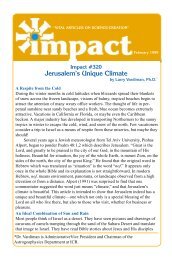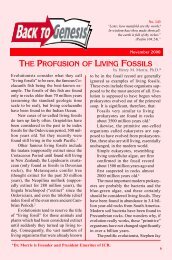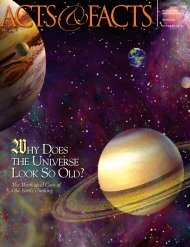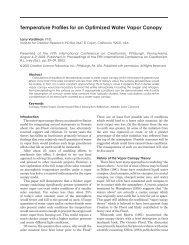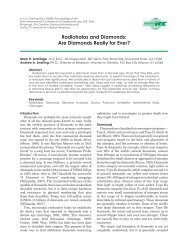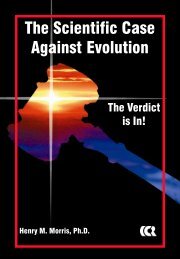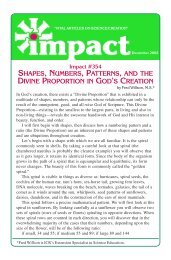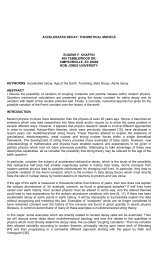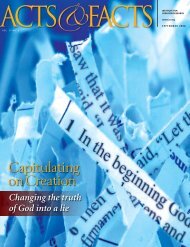Acts & Facts - Institute for Creation Research
Acts & Facts - Institute for Creation Research
Acts & Facts - Institute for Creation Research
You also want an ePaper? Increase the reach of your titles
YUMPU automatically turns print PDFs into web optimized ePapers that Google loves.
The Gaps in “The God of the Gaps”B R I A N T H O M A S , M . S .Is a “god of the gaps” at the root of IntelligentDesign (ID) and creation science?This in<strong>for</strong>mal logical fallacy occurs whena given mystery (or gap) that sciencehas not solved is “explained” with reference todivine activity: “God just made it work out,somehow,” some theists might say.For example, science cannot yet fundamentallyexplain why atomic nuclei, packedwith positively charged and repelling protons,do not fly apart. “God of the gaps” reasoningwould posit that God simply holds them together.The standard model of particle physics,in contrast, holds that an enigmatic “nuclear<strong>for</strong>ce” keeps them together. (But this also seemsfaith-based—perhaps using a “nature of thegaps” concept.) If, however, a new property ormodel of atoms is found that can explain thisatomic cohesion, then invoking either the divineor some natural <strong>for</strong>ce to fill in “the gap”will become unnecessary.Contrary to the claims of ideologicalnaturalists, “god of the gaps” thinking doesnot characterize the central tenets of either IDor creation science. ID specializes in detectingdesign, just like archaeologists and <strong>for</strong>ensicsscientists, who carefully examine artifacts orevents to determine whether they were manufacturednon-naturally. ID researchers likewiseinfer a designer from the observation of purposefullyplaced patterns.For example, after studying a bi-directionallyrotating molecular machine like ATPsynthase—complete with a stator, anchor, axle,and rocking cams—ID scientists do not concludethat “God must have made it because wewant to believe in a God.” Rather, they reasonthat an intelligent entity, though left undefined,must have crafted it precisely because of the inferencefrom machine to machinist: “So we inferdesign on the basis of what we know ratherthan what we don’t know.” 1<strong>Creation</strong> scientists do not use “god of thegaps” reasoning either. Their approach is somewhatthe opposite. They begin with Scriptureas a reliable source of historical, scientific, andtheological in<strong>for</strong>mation. Then, they endeavor tofill in the missing pieces by using either inductiveorigin science or deductive empirical science.When critics mistakenly assume thatcreator-friendly views use the “god of the gaps”fallacy, it leads them to impose another faultyaccusation. They maintain that the “God didit” mentality stifles motivation <strong>for</strong> meaningfulscientific inquiry. Science Historian at CornellUniversity Will Provine “described intelligentdesign as an ‘utterly boring’ theory, one thatoffers the ‘same answer <strong>for</strong> every irreduciblemechanism.’” 2 And since science can’t be donewithout an innate curiosity, they reason, creationistsare not actually scientists.However, this reasoning rests upon theprior faulty assumption that ID and creationscience use “god of the gaps” thinking, and itignores real history. Since ID advocates focuson probing objective evidence <strong>for</strong> intelligence,and since creation scientists work to fill gapsin scriptural knowledge with scientific investigation,then neither group is using the “godof the gaps.” Rather, both are quite interestedin science.In fact, it was the intense scientific interestsof creationists that gave birth to modernscience in the 18th and 19th centuries, establishingthe major disciplines still in use today.If any discipline is to be considered invalid becauseit is too boring or because it infers design,then by the same logic archaeology and theSearch <strong>for</strong> Extraterrestrial Intelligence are likewiseinvalidated.As mentioned above, many of the samecritics who swing the “god of the gaps” club attheir ideological competitors, nonetheless takerefuge in their own “nature of the gaps” reasoning.Nature is assumed, <strong>for</strong> example, to havespontaneously generated matter from nothing;atoms, galaxies, stars, and planets froman explosion; and life from non-living soup.Well-educated people, wise enough to includethe Creator in their thinking, need not fear thespecious accusation that they are relying on the“god of the gaps.”References1. Dembski, W. and S. McDowell. 2008. Understanding IntelligentDesign. Eugene, OR: Harvest House Publishers, 98.2. Provine Talks on IntelligentDesign Debate. CornellDaily Sun, October 25, 2005.Accessed online September23, 2008.3. Morris, H. 1982. Bible BelievingScientists of the Past.<strong>Acts</strong> & <strong>Facts</strong>. 11 (1).Mr. Thomas is Science Writer.NOVEMBER 2008 • ACTS&FACTS15



